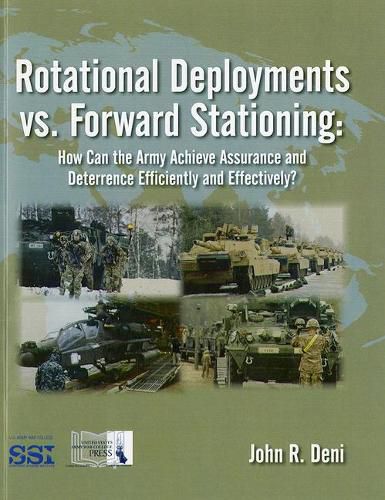Readings Newsletter
Become a Readings Member to make your shopping experience even easier.
Sign in or sign up for free!
You’re not far away from qualifying for FREE standard shipping within Australia
You’ve qualified for FREE standard shipping within Australia
The cart is loading…






The Army’s force posture is out of balance, with a greater percentage of troops stationed in the United States than at any time since the late 1940s. This has forced an over-reliance on lengthy, continuous rotational deployments to achieve deterrence and assurance in theaters such as northeast Asia and Europe. This finding is based on a 9-month study assessing the costs and benefits of rotational deployments and forward stationing. The analysis reveals that, in terms of fiscal cost, training readiness, morale and family readiness, and diplomatic factors, the United States could likely achieve deterrence and assurance objectives more efficiently and more effectively with increased forward stationing. The recommendations address what kinds of units would be best suited for forward stationing, where forward stationing would be most efficacious, and how the Department of Defense should go about rebalancing Army force posture.
Audience: U.S. military leadership, strategic planners, military historians, and policy advocates may be most interested in this work as it analyzes force stationing compared to rotational military deployments to foreign lands (which involves training and equipment readiness in preparation for combat deployment). Additionally, students pursuing coursework in military science, defense/military policy, public administration, strategy, and program management may be interested in this text relating to United States military decision-making and strategic planning.
Related products:
Managing Military Readiness can be found here: https: //bookstore.gpo.gov/products/managing-military-readiness
Military Engagement and Forward Presence: Down But Not Out as Tools to Shape and Win can be found here: https: //bookstore.gpo.gov/products/military-engagement-and-forward-presence-down-not-out-tools-shape-and-win
Other than War: The American Military Experience and Operations in the Post-Cold War Decades is available here: https: //bookstore.gpo.gov/products/other-war-american-military-experience-and-operations-post-cold-war-decade
Options for Restructuring the Army can be found here: https: //bookstore.gpo.gov/products/options-restructuring-army
$9.00 standard shipping within Australia
FREE standard shipping within Australia for orders over $100.00
Express & International shipping calculated at checkout
The Army’s force posture is out of balance, with a greater percentage of troops stationed in the United States than at any time since the late 1940s. This has forced an over-reliance on lengthy, continuous rotational deployments to achieve deterrence and assurance in theaters such as northeast Asia and Europe. This finding is based on a 9-month study assessing the costs and benefits of rotational deployments and forward stationing. The analysis reveals that, in terms of fiscal cost, training readiness, morale and family readiness, and diplomatic factors, the United States could likely achieve deterrence and assurance objectives more efficiently and more effectively with increased forward stationing. The recommendations address what kinds of units would be best suited for forward stationing, where forward stationing would be most efficacious, and how the Department of Defense should go about rebalancing Army force posture.
Audience: U.S. military leadership, strategic planners, military historians, and policy advocates may be most interested in this work as it analyzes force stationing compared to rotational military deployments to foreign lands (which involves training and equipment readiness in preparation for combat deployment). Additionally, students pursuing coursework in military science, defense/military policy, public administration, strategy, and program management may be interested in this text relating to United States military decision-making and strategic planning.
Related products:
Managing Military Readiness can be found here: https: //bookstore.gpo.gov/products/managing-military-readiness
Military Engagement and Forward Presence: Down But Not Out as Tools to Shape and Win can be found here: https: //bookstore.gpo.gov/products/military-engagement-and-forward-presence-down-not-out-tools-shape-and-win
Other than War: The American Military Experience and Operations in the Post-Cold War Decades is available here: https: //bookstore.gpo.gov/products/other-war-american-military-experience-and-operations-post-cold-war-decade
Options for Restructuring the Army can be found here: https: //bookstore.gpo.gov/products/options-restructuring-army